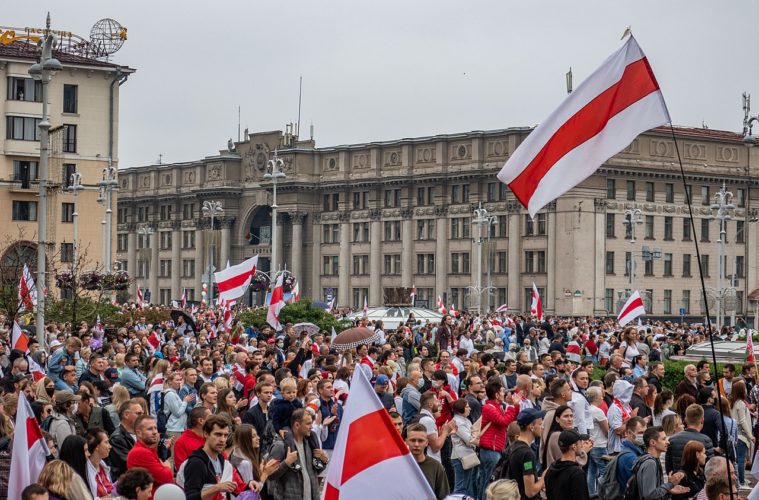Since August 2020, mass protests have shaken Belarus, building momentum in its capital Minsk and eventually spreading throughout the entire country. The protests erupted after the August 9 presidential elections, which saw the self-proclaimed victory of President Aleksandr Lukashenka against Sviatlana Tsikhanouskaya, a human rights activist and leader of the opposition. Leaders across the European Union, along with the U.S. government, have since proclaimed the election results illegitimate and refused to recognize Lukashenka as president.
Tsikhanouskaya first decided to run for office in May 2020, following the arrest of her husband Sergei Tsikhanouski, activist and Youtube blogger, who set out to challenge Lukashenka for the presidency. Tsikhanouski was jailed during an earlier wave of protests against the government’s handling of the COVID-19 crisis.
Following the announcement of the election results, which protesters dubbed fraudulent, Belarusians took to the streets to demand fair elections and protest corruption that has plagued the country in recent years. The response of the Lukashenka regime to peaceful protests was fierce, with police forces openly committing violence against civilians in the streets of Minsk. Four people are confirmed to have died during demonstrations or after arrest by the authorities since August, but the UN Special Rapporteur has suggested the real death toll may be higher.
The role of symbolism
Since the early 2000s, protests and revolutions have been common across the post-Soviet space. The most notable examples are the so-called ‘color revolutions’ that sprang up in multiple countries, including the Rose Revolution in Georgia in 2003 and the 2004 Orange Revolution in Ukraine.
Symbolism was a prominent feature of the color revolutions. For example, Ukraine’s Orange Revolution earned its name because of the use of the color orange by the campaign of presidential candidate Viktor Yushchenko. Ukrainian protesters came out to the streets wearing orange items. This communication through symbols bolstered protesters’ messages.
We again see symbolism in the ongoing protests in Belarus. Belarusians have adopted the flag of the Belarusian Republic for their demonstrations. This red-and-white flag was the national flag of independent Belarus for a brief period after the fall of the Soviet Union. It remained in use from 1990 to 1995, until the first election of President Lukashenka. In the last decades, the flag has become the symbol of the opposition and has made appearances at different protests that took place during Lukashenka’s six presidential terms. In 2020, the protest marches in Minsk turned red-and-white as thousands of citizens brandished the former national flag.
A new Euromaidan?
At first glance, the ongoing protests in Belarus may strongly resemble the 2013-14 Euromaidan protests in Ukraine. These began when then-President Viktor Yanukovich refused to sign the Ukraine-European Union Association Agreement. Weeks of protests and violence followed, culminating in the Crimean peninsula’s declaration of independence through an internationally unrecognized referendum and its annexation by Russia. Shortly after, a separatist war broke out in the eastern region of Donbas.
In different ways, comparing the two movements makes sense. Both Euromaidan and the 2020 Belarus protests grew from disenchantment with political corruption and accusations of electoral fraud. In both cases, the movement gained force as local police and security forces committed violence against protesters, resulting in injuries and deaths. Finally, Ukraine and Belarus are both of great cultural significance to Russia: they are the only Eastern European states that were continuously part of a wider Russia for hundreds of years since the founding of Kievan Rus’ in the 9th century.
Nonetheless, there is an important difference between the two: the expressed desire to join the European Union. While Belarusian protests began to contest election results, Euromaidan launched with the express purpose of opposing Yanukovych’s unilateral decision not to sign the EU Association Agreement. The different symbols adopted by the two movements also speak to this difference. Ukrainians marched on the Maidan waving Ukrainian flags alongside those of the EU. Belarusian protesters in Minsk are chanting for justice and fair democracy, with no EU flags in sight. There appears to be no evidence of a willingness among Belarusians to move closer toward the E.U., at least for the moment. Neither are Belarusians advocating for reducing economic and diplomatic ties with Russia, unlike the Ukrainians in 2013.
International implications
The protests in Belarus continue to draw international attention, which should come as no surprise given their major implications for regional geopolitics. Major players, notably Russia and China, congratulated President Lukashenka after his self-proclaimed victory, legitimizing his regime. Meanwhile, the E.U. has refused to recognize the legitimacy of the elections and condemned violence perpetrated against protesters. In addition, the union imposed sanctions on 55 individuals affiliated with Lukashenka, including his son and National Security Adviser Viktor Lukashenka and Minister of Internal Affairs Yuri Karayev. Lukashenka, in turn, has responded with retaliatory sanctions against the E.U. The Belarus protests may pose another serious challenge for the relations between Russia and Europe as their positions are in direct conflict.

